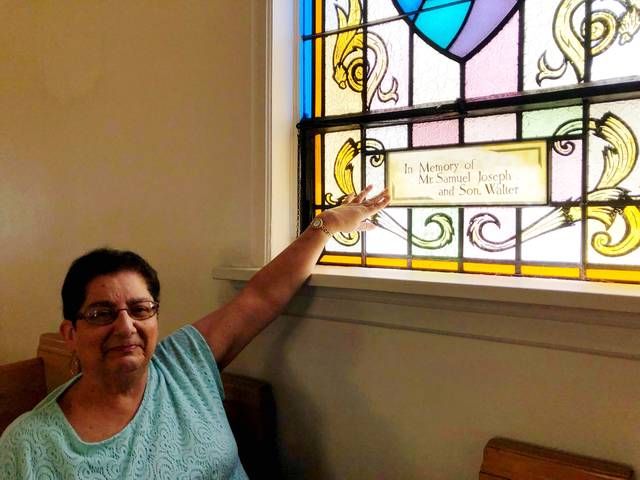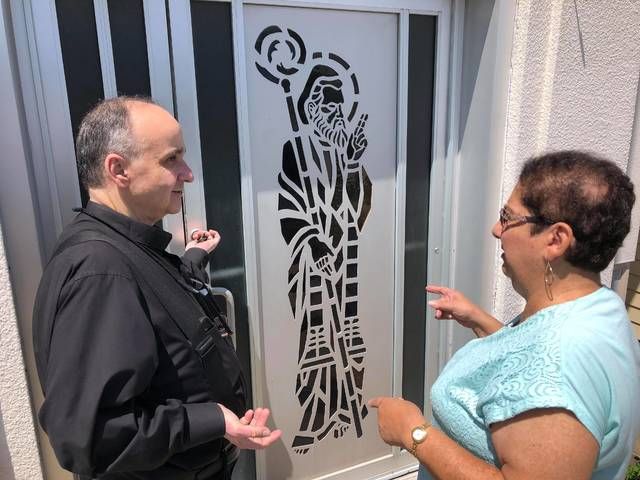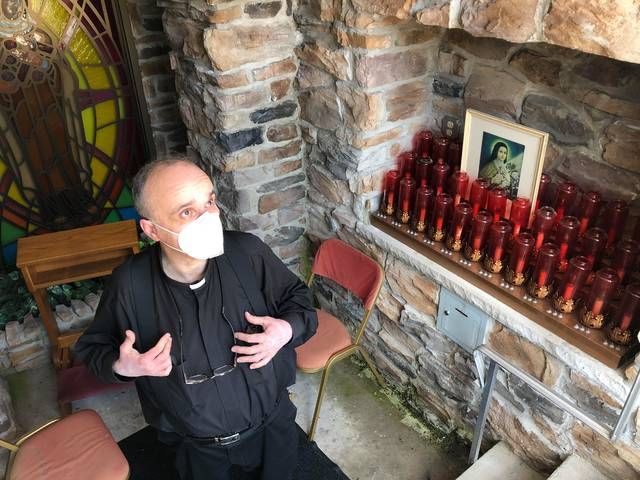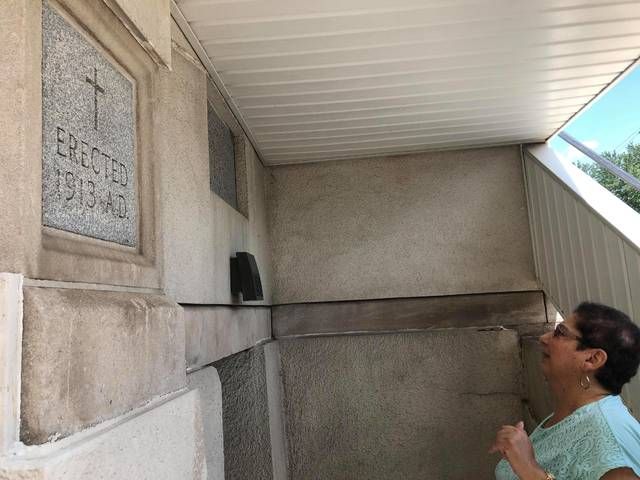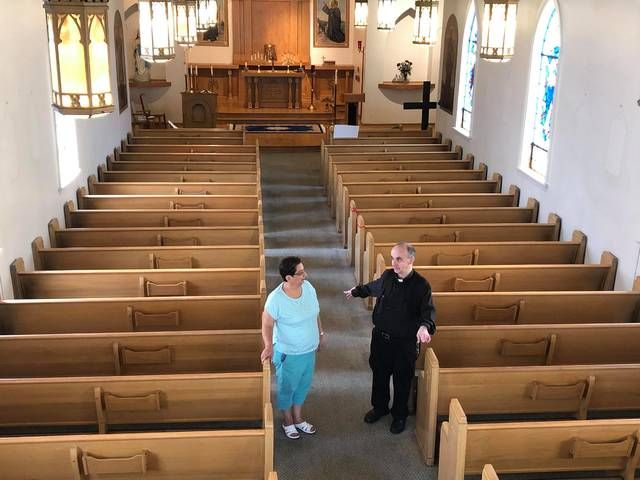
Father Paul Damien, right, talks with lifelong parishioner Linda Joseph at St. George Maronite Church on Loomis Street in Wilkes-Barre. The 1913 church building, whose parishioners now worship at the St. Anthony site on Park Avenue, is up for sale.
Roger DuPuis | Times Leader
St. George Maronite Church opened in 1913; new rectory under construction opposite St. Anthony site
Click here to subscribe today or Login.
WILKES-BARRE — For more than a century, St. George Maronite Church on Loomis Street served generations of the city’s Lebanese community and other Maronite Christians.
Now, it’s time for the current generation of parishioners to bid a quiet farewell to the building that has been central to their faith community since 1913.
With all services effectively moved to St. Anthony Church on Park Avenue two years ago, the Loomis Street church and rectory are now up for sale, and a new rectory is under construction at Park Avenue and Dana Street.
It is a bittersweet moment — and one that will pass without formal ceremony due to the ongoing COVID-19 outbreak — but that didn’t stop Father Paul Damien and members of the parish from reflecting on the history of the Loomis Street church last week.
“The best of times were those days of our annual bazaar,” recalled Robert J. Decker, who was baptized at St. George in 1957, confirmed there in 1966 and married to his wife, Carol, in the church in 1979.
“We would have Loomis Street blocked off where Loomis meets Jones Street at the top of the hill and at the bottom of the hill where it meets Stanton Street,” Decker added. “Everyone, I mean families and friends, would gather and enjoy the freshly made mid-Eastern foods and pastry, the Arabic music and live entertainment … everyone loved our bazaar.”
Maronites are an Eastern Catholic religious group whose members mostly come from Lebanon.
Linda Joseph, whose grandfather was one of five men who started St. George, is another lifelong parishioner who has been active in the parish — from worship to working in the rectory and serving on boards — since she was in her 20s.
Almost everyone in the church traced their ancestors back to the village of Hardine, Lebanon, Joseph said.
“Our whole lives were centered around the church. The entire area here, all the surrounding streets, were Lebanese families,” Joseph explained. “Everybody was basically related, and if you weren’t, you were treated like you were related anyway. It was one big family.”
That is very much in keeping with the way Maronite families still worship in Lebanon said Father Damien, who is a native of Lebanon.
Parish history
According to accounts provided by Joseph and the parish’s website:
The first two Maronite immigrants arrived in Wilkes-Barre in 1887. With the arrival of more relatives and friends, a small community began to develop.
With no church of their own, they worshipped at the area’s Latin Rite Catholic churches, although Maronite priests would visit the region.
By 1911, however, the community was in a position to establish its own church — in the event, two separate parishes were created, St. George and St. Anthony.
Joseph Ferris, Joseph George, Samuel Joseph, Anthony Shiner, and Joseph Thomas were the founding members of St. George on Loomis Street, which held its first Divine Liturgy on March 23, 1913, celebrated by the Rev. Abdallah Torobay.
Over the decades the parish also produced two vocations: Msgr. Bill Bonczewski and Father Bill Decker.
It may also be remembered by many, however, for Novena to St. Therese of the Infant Jesus, also known as Saint Therese of Lisieux, which continues to this day at St. Anthony.
The Novena was established during the pastorate of Rev. Joseph Solomon (1926-32). A statue of St. Therese was purchased from the Carmelite convent in Lisieux, France in early 1927 through the efforts of Msgr. Stephan Doueihi, who also obtained the relic of St. Therese from that convent.
During an interview last week, Joseph and Father Damien showed a book full of letters from people who wrote to thank St. Therese, and the church, for miracles performed in their lives after praying to St. Therese and attending the Novena.
St. Therese is memorialized in a small grotto below the main entrance, with a portrait and candles and some items commemorating those miracles attributed to her. They will be moved prior to the sale.
Changing demographics
As members grew old and died, or moved away, the parish community has diminished in size — 114 parishioners have passed away in the last decade alone, Father Damien said.
In 1997 the process of creating a single, unified parish began, and the parish of St. Anthony + St. George was created. The Park Avenue church became main site and Loomis Street was designated as a chapel.
In 2018 all daily and weekend liturgies, as well as the St. Therese weekly Novena, were moved to the St. Anthony site on Park Avenue.
“But then of course, as time went on and we lost more people, we came to realize we couldn’t maintain both buildings and came to the conclusion that we have to sell,” Joseph said.
That process began a few months ago, and Father Damien said there has been interest in the properties. Cleaning and moving items was underway during a visit last week.
Eternal memories
During a walk through the Loomis Street church, Joseph and Father Damien pointed out items large and small that recall its generations of worshippers.
One stained glass window, for example, is dedicated to Joseph’s grandfather, and her uncle Walter, who was lost at sea during World War II.
“I’ve been a member since the day I was born. I was baptized here, confirmation, all my sacraments. My family lived right next door. This was their homestead,” Joseph said.
Decker, in written recollections, noted that his own parents, Victor and Genevieve, were married at St. George in 1952, while his own children — Robert, Alicia and Tara — also belonged to the church.
He also thought back to those popular bazaars, when uncle Joe Elias would take the stage and sing for the crowd.
“These are a few of the many wonderful memories I have of St. George,” Decker said. “The building will be missed but the memories and the people will never be forgotten.”
And, Joseph added, the Maronite community in Wilkes-Barre will now have a united location in every sense of the word.





